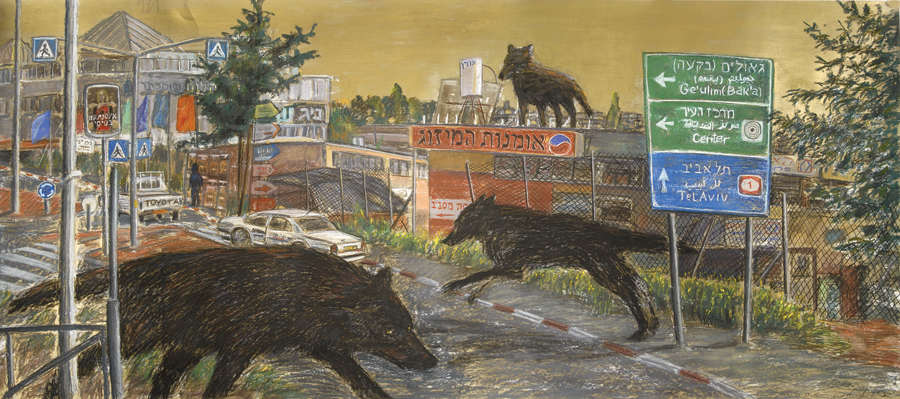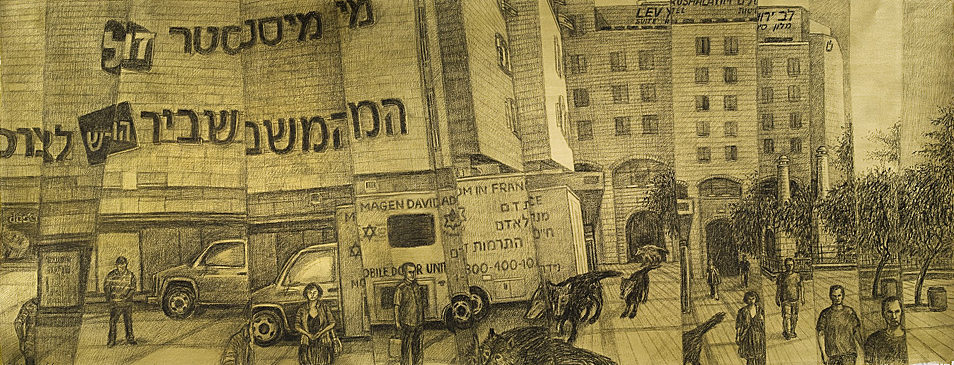
The Wolves of Branches / Lena Zaidel
The wolves and other wild animals that have appeared in my works over the last decade have become for me a symbol of liberation and freedom. They represent positive forces of the psyche: connection to nature, vitality, and healthy instincts. The image of the wolf in my works never represents the enemy, but conceals within itself the ability to bring about a shift in the perception of reality and to change the meaning of what is seen.
The image of the wolf has gone through many transformations in my paintings. It first appeared in pencil drawings, then in charcoal, then in dry pastel, in acrylic, and finally, the drawing lines turned into twigs – the image of the wolf materialized into a sort of three dimensional statue woven out of thin branches.
For me, the wolf statues that I have constructed echo qualities of ancient ritual totems. They are connected to the issue of ecology and elicit reflection not only on the ancient connection to nature, but also on nature itself having become a victim. I see the wolves as representing a point of encounter between nature and civilization: not only as a reminder of a primal existence, but also as a warning sign.
2016

The Image of the Wolf
The wolves wake Jerusalem from its deep slumber, shaking up its streets and sacred sites. Nothing remains unaffected where the wolves have passed. The wolves threaten outdated perceptions, and personal, social or political fanaticism or dogma. They also threaten the tedious daily routine, which dulls one´s senses, vision and thinking. The scenes take place on the fault line between civilization and wilderness and depict the encounter between the wild and culture. The wolves appear as regiments of the Salvation Army, shaman-healers who grant the city its purity and promise of a new future. They are a reminder of untamed vitality, nature´s magic, alert instinct and intuition, challenging structured and linear thinking. As they run through the city´s streets they are transformed into a sign, a symbol, a magic spell that is repeated again and again.

Broken Hearted City Center
In the series “Broken Hearted City Center” (2008 – 2010), the wolves pass through replicated urban spaces. The pieces address the issue of time, as well as visual perception, accompanied by our eyes´ perpetual blinking. The idea of dividing the landscape into segments comes from the phenomenon of blinking. As a result of this division, three tenses – past, present and future – come into simultaneous existence on the drawing´s surface. The series attempts to expand the elements constituting a unit of time – “before”, “during” and “after” the wolf – later reconstructing the moment.

Nayedet Mada
Nayedet Mada (Magen David Blood Drive Van) from the series Broken Hearted City Center portrays the Mashbir plaza in Jerusalem and raises the question: Is the reality portrayed here in a process of full reunification, or is it a moment before utter disintegration? The name of the department store itself, maShBiR (provider), suddenly exposes how ShaViR (fragile) it inherently is.
The sign for the Hotel Lev Yerushalayim jumps up and down on the building like a seismograph. The slogan on the Blood Drive Van, “One unit of blood is life for someone,” disintegrates into lone words. The building structures replicate themselves, as though stuttering. The Talithakumi building appears twice. Everything splits and breaks, duplicating and tripling, as if aspiring to expose the multifacetedness of the reality that is in constant motion.
Most of the images are ambiguous: the presence of the Blood Drive Van can suggest impending danger or just the opposite – a calming message of salvation and hope. And the pack of wolves crossing the plaza arouses conflicting feelings: the presence of wolves is a concern and a threat, while on the other hand they appear to be lively and totally unaggressive passersby.
Drawing in charcoal on a gold background reflects for me the reality in Jerusalem. Charcoal symbolizes ashes, the earth and its produce. Gold symbolizes the sublime, the spiritual and the holy. This nearly impossible connection embodies the paradox – or fracture – and represents the sharp contrasts that Jerusalem continues to magnetize to itself.
Show More